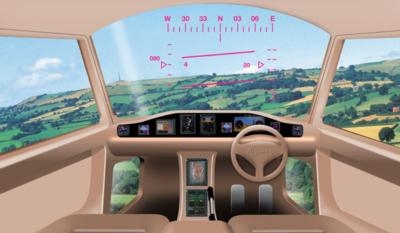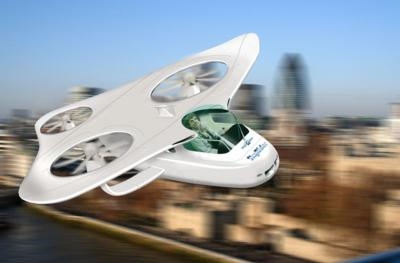Wed, Dec 10, 2014
EU-Funded Researchers Are Behind A New Helicopter Steering Mechanism That Could Open The Door To 'Flying Cars'
European Union-funded researchers with the MYCOPTER project say they have developed a steering system that makes helicopters as easy to control as cars. While having your own personal aerial vehicle (PAV) may still be some way off, the success of the project opens up the possibility that one day flying vehicles could indeed be an integral part of the urban transportation network.

Currently, only pilots who have undergone extensive training can fly a helicopter. Four control axes must be operated in order to maintain a stable position in the air. This requires skill, knowledge and concentration. In order to extend aerial flying to the general public, PAV operation needs to be significantly simplified, with a greater degree of automation introduced.
The MYCOPTER project started in 2011 with the objective of developing a PAV ideally designed for travelling between the home and the workplace. The project envisioned that the vehicle would fly at a low altitude in urban environments, be fully or partially autonomous without requiring ground-based air traffic control and would operate outside controlled airspace. Current air traffic would therefore remain unchanged, ensuring that PAVs could be easily be integrated into the next generation of controlled airspace.
To achieve this, the project replaced the helicopter’s cyclic stick, which is responsible for movements around the longitudinal and transverse axis, with a steering wheel. Pilots simply need to turn the wheel in the intended direction. The MYCOPTER team believes that this represents an important step in making PAVs more accessible to the general public.
Test models were implemented on unmanned aerial vehicles, motion simulators, and a manned helicopter. The project also focused on collision avoidance systems, pilot training and overall streamlining of helicopter control processes. New automation technologies for obstacle avoidance, path planning and formation flying were developed and successfully tested. The MYCOPTER project sought to assess how the benefits of automation could be implemented while still providing the pilot with the ability to feel in control.

The success of the MYCOPTER project suggests that the eventual implementation of a Personal Aerial Transportation System (PATS) could be feasible. Such a system would have a beneficial impact on citizens’ daily lives by helping to resolve issues related to traffic congestion and even environmental pollution.
For example, an aerial transportation network would enable commuters to avoid sitting in traffic queues and instead travel directly between two points. Travelling directly point to point could also save on fuel and help to reduce the stop and go traffic that wastes large amounts of energy.
Outside of this particular project, new battery operated aerial vehicles are currently being developed which could provide further environmental improvements. Less road congestion might also lead to cost savings in terms of road maintenance and associated support structures.
The results of the project, due for completion at the end of 2014, were recently demonstrated and discussed at the German Aerospace Centre (DLR) in Braunschweig, Germany on November 20, 2014.
(Images provided by MYCOPTER. Artist's concepts of vehicle's cockpit, PAV)
More News
Instrument Approach Procedure (IAP) Charts Portray the aeronautical data which is required to execute an instrument approach to an airport. These charts depict the procedures, incl>[...]
“Our industry is approaching a 30-year innovation cycle, and we have less than 25 years to decarbonize aviation. We need to develop new methods to get net zero aerospace tech>[...]
Also: Girls in Aviation Day, B-29 Doc Heads 4 Chino, C-17 Tail Cone Detaches, Bulgaria Airshow Accident One of two private aircraft that launched from Apatity Airport near Murmansk>[...]
From 2021 (YouTube Version): We Were Blown Away At How Well The Nosewheel Was Adapted To The X Cub Airframe It should not be a secret to any one of you, that with thousands of hour>[...]
Also: Volato Nixed by Honda, New B-21 Bases, A-10 Unit Inactivated, Gogo/Airshare Boom Supersonic announced its demonstrator aircraft XB-1 successfully completed its third test fli>[...]
 ANN's Daily Aero-Term (09.17.24): Instrument Approach Procedure (IAP) Charts
ANN's Daily Aero-Term (09.17.24): Instrument Approach Procedure (IAP) Charts Aero-News: Quote of the Day (09.17.24)
Aero-News: Quote of the Day (09.17.24) Airborne 09.16.24: Bristell Shooting, EAA v FAA, Boeing Strike!
Airborne 09.16.24: Bristell Shooting, EAA v FAA, Boeing Strike! Classic Aero-TV: CubCrafters NX Cub-A Stunning Effort To Build The Perfect Cub'
Classic Aero-TV: CubCrafters NX Cub-A Stunning Effort To Build The Perfect Cub' Airborne 09.18.24: Boom XB-1 3rd Test, DJI Ban, SubSonex To EAA Museum
Airborne 09.18.24: Boom XB-1 3rd Test, DJI Ban, SubSonex To EAA Museum




